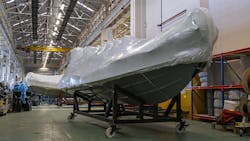Inflatable Boats Bring Full-Blown Service
Inflatable boats may sound like vehicles for casual use. However, when they are rigid inflatable boats (RIBs), they are versatile solutions for any number of coast guard duties, as BAE Systems recently discovered. The company sold six of its Pacific 24 (P24) RIBs to the Australian prime contractor Austal to equip two Cape-class patrol boats being built for the Trinidad and Tobago Coast Guard. The small but agile RIBs (see figure) support many different missions, including force protection, search and rescue, and counter-piracy operations. It is rugged, secure, and fuel efficient with performance that appeals to military customers, such as the Royal Navy, as well as civilian customers. The advanced hull construction employed in the MKIV version of the P24 RIB provides extra levels of safety as complying to safety of life at sea (SOLAS) testing procedures.
Austal’s Head of Supply Chain and General Manager for New Builds, Ben Wardle, said it was a clear choice of maritime vessel: “The MKIV Pacific 4 from BAE Systems was the first choice of sea boat for the Trinidad and Tobago Coast Guard. Our customer needs assurance that their sea boats can perform in life and death scenarios in harsh maritime environments, including in tropical storm and hurricane conditions. The pedigree of the P24, with its range of international customers including the military, as well as its SOLAS accreditation, made it the ideal vessel for the job.”
The P24 RIBs supplied to Austal provide seating arrangements for six passengers and two crew members, with removable seats to accommodate any special Coast Guard carrying requirements. These modified versions of the P24s also include a ground plate for Austal to install its own radio communications equipment. The P24 RIB is widely used in the Royal Navy’s surface fleet, embarked on several warships and Royal Fleet auxiliary vessels including the latest aircraft carriers, the HMS Queen Elizabeth and the HMS Prince of Wales.
About the Author
Jack Browne
Technical Contributor
Jack Browne, Technical Contributor, has worked in technical publishing for over 30 years. He managed the content and production of three technical journals while at the American Institute of Physics, including Medical Physics and the Journal of Vacuum Science & Technology. He has been a Publisher and Editor for Penton Media, started the firm’s Wireless Symposium & Exhibition trade show in 1993, and currently serves as Technical Contributor for that company's Microwaves & RF magazine. Browne, who holds a BS in Mathematics from City College of New York and BA degrees in English and Philosophy from Fordham University, is a member of the IEEE.
